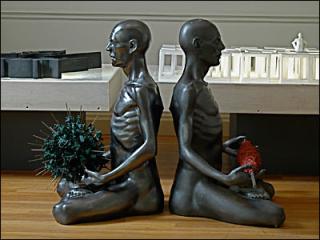Advertisement
Can there be such a thing as “Unitarian art”? After all, there is Christian art, Buddhist art, Islamic art, and so on. And if there were Unitarian art, what would it look like? In the 1960s, Bruce Nauman made work so unconventional that observers questioned whether it could be called art at all. To which Nauman famously replied, “If I was an artist and I was in the studio, then whatever I was doing in the studio must be art.” Following this logic I mused: “If I’m an artist, and I’m a Unitarian, whatever I do must be Unitarian art.”
For this collaboration, Jeremy Chu and I engaged in a “visual dialogue” with the goal of deepening our interpersonal understanding and bridging our gap in age, race, and nationality. Jeremy is a Singaporean artist of Mandarin Chinese descent; I am an American of Anglo-Saxon descent. He was 30; I was 65. Yet on an artistic and intellectual level we were connected. And we were friends.
Jeremy and I met about twenty times for the project. To each meeting we brought a specific theme to explore verbally, and then we would go to our studios to create a visual response. We talked about such things as childhood memories, “universal” archetypes, and other symbols and metaphors.
The two seated figures are identical, symbolizing our common humanity. They sit in the lotus position, a symbol of mental concentration, and they hold objects representing childhood memories.
One figure holds a net made of rubber bands rolled on a spindle. It was created by Jeremy and represents the web of his Chinese ancestry. Enmeshed in the net are photographs of his grandmother, the matriarch of the family. The net was made of a particular kind of red rubber band that Jeremy had played with as a child. The second figure holds a ball of my favorite childhood toy: G.I. Joes. I played “shoot ’em up” until I was 13, well past the gunplay age for most boys.
In one of our conversations we focused on the maze, one of Jung’s “universal” archetypes. For us, the mazes behind the figures represent the attempt of two people to find their way to one another.
So where is the “Unitarian” in all this? First, there is a Unitarian covenant to “seek the truth in love,” and the key requirement for love is understanding. Second, Unitarianism teaches tolerance for those who are different from us. And finally, Unitarian Universalism is Humanistic, built on the desire of people to connect in meaningful ways. That is the underlying principle of this piece of “Unitarian art.”
Adapted from a talk delivered at the Harvard Unitarian Universalist Church in Harvard, Massachusetts, on May 24, 2009, in conjunction with the installation of the artwork in the church.
Related Resources
- Geoffrey Koetsch: Exhibitions. Artist’s website. (koetsch.com)
